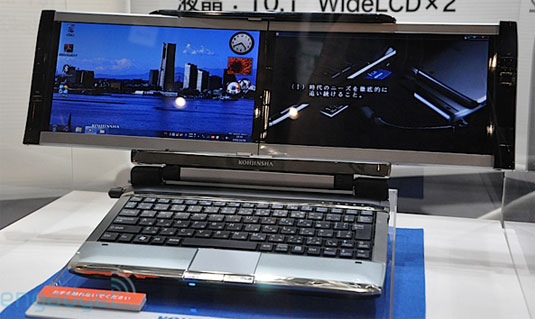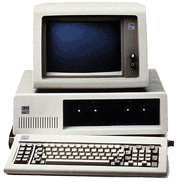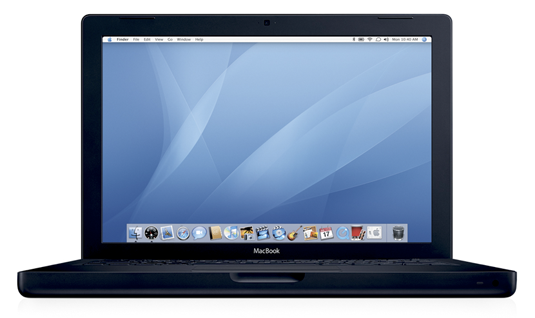Toshiba announced new notebooks today–a bevy of updates to its consumery Satellite line, which encompasses everything from basic low-cost laptops to powerful entertainment machines. Laptopmag.com has a nice summary. Herewith, notes on a few models I found particularly interesting when Toshiba briefed me on them recently.
Tag Archives | Notebooks
Toshiba's Latest Lightweight?
A 2.2lb, 13″ Toshiba laptop with USB 3.0, a fast CPU, and a new technology that charges the battery in minutes? Sounds good to me.
No comments
New HP Notebooks: Envy Updates, Posher Pavilions, AMD (Almost) Everywhere
HP announced scads of new notebooks today. I’m not going to try and cover every detail on every model. But here are a few notes on items I found interesting. (I was briefed by the company and saw the new systems in person.)
3 comments
Please Sir, May I Have More Memory?
 Good news, maybe, sort of: Fudzilla is reporting that Intel will allow netbook manufacturers who use an upcoming version of its low-end Atom CPU to sell machines with 2GB of RAM rather than today’s artificial maximum of 1GB. That would allow for nicer, better-performing netbooks that don’t cost a whole lot more. Of course, it also begs the question: Why is Intel involved in deciding how much RAM a netbook can have in the first place? It’s a little as if the company that manufactured my home’s furnace wanted to be involved in deciding the capacity of my washing machine.
Good news, maybe, sort of: Fudzilla is reporting that Intel will allow netbook manufacturers who use an upcoming version of its low-end Atom CPU to sell machines with 2GB of RAM rather than today’s artificial maximum of 1GB. That would allow for nicer, better-performing netbooks that don’t cost a whole lot more. Of course, it also begs the question: Why is Intel involved in deciding how much RAM a netbook can have in the first place? It’s a little as if the company that manufactured my home’s furnace wanted to be involved in deciding the capacity of my washing machine.
The PC industry–even the parts of it who are selling tons of netbooks–have an amazing track record of disparaging the darn things and explaining why consumers don’t really want them. But some of the limitations of netbooks are manufactured: Both Intel and Microsoft impose restrictions on PC manufacturers that ensure that netbooks are less appealing than they might otherwise be, and therefore less imposing competition for more traditional, full-featured, profitable notebooks–ones that typically contain costlier Intel chips and run higher-priced versions of Windows.
Almost everyone in the computer industry would rather that consumers reject netbooks and buy somewhat more expensive, powerful thin-and-light notebooks with ultra-low voltage processors. And in many cases, those machines make a lot of sense. But wouldn’t it be nice if said consumers could choose between the best possible netbook and the best possible thin-and-light?
5 comments
Is This Twice the Netbook?
Engadget’s Ross Miller is attending CEATAC in Tokyo–it’s the Consumer Electronics Show of Japan, only far weirder–and among the gizmos he’s encountered is a prototype of a netbook with two screens (photo borrowed from Engadget):

My instinctive response to dual-screen laptops of all sorts (which I wrote about here) is that they take the best thing about portable computers–the fact that they’re easy to quickly and efficiently use almost anywhere–and mess it up. If you want more pixels than an ordinary netbook provides, wouldn’t it be more practical to buy a larger, higher-resolution single-screen notebook? Wouldn’t this machine intrude on your seatmate’s real estate if you tried to use it on an airplane? And I like to take laptops literally and use them on my lap…a scenario in which double-screen models seem particularly unwieldy.
Every time I look at a two-screener, including this one, it seems to say “We’re doing this because it’s technically feasible, not because real people would want to use this in the real world.”
Then again, you could argue that real people have never gotten the chance to give two-screen notebooks a yay or a nay–yery few of the dualies that have been invented have ever made it to market. Do you think it’s an idea that’ll ever catch on?
3 comments
Are You Done With Desktops?
 I recently had a minor epiphany: I’m probably never going to buy another desktop PC. It shouldn’t have come as a revelation given that the last one I got (in January of 2007) sits largely unused, except when I need to grab a particular old file off its hard drive. Laptops give me everything I need from a computer, and their downsides–smaller screens, lower-capacity hard drives–are far outweighed by their multiple virtues.
I recently had a minor epiphany: I’m probably never going to buy another desktop PC. It shouldn’t have come as a revelation given that the last one I got (in January of 2007) sits largely unused, except when I need to grab a particular old file off its hard drive. Laptops give me everything I need from a computer, and their downsides–smaller screens, lower-capacity hard drives–are far outweighed by their multiple virtues.
Market share figures show that the world’s made the leap to laptops, too–they’re the planet’s default personal computer, and it’s desktops that are now the variant device.
Which leads to today’s two-part T-Poll..
21 comments
5Words for Wednesday, August 26th 2009
Like 5Words? Subscribe via RSS.
Snow Leopard gets malware blocker.
Science says multitasking is bad.
2 comments
The Power Shortage Continues
 Robert S. Anthony of The Paper PC has a fun post up about a new Wi-Fi reading room at the New York Public Library. It’s an “elegant” venue with seats for up to 128 laptop users–and if you don’t have a netbook, they’ll loan you one. Sounds fabulous–except there are no power outlets at the seats. If you’re using the Wi-Fi you’re draining your battery.
Robert S. Anthony of The Paper PC has a fun post up about a new Wi-Fi reading room at the New York Public Library. It’s an “elegant” venue with seats for up to 128 laptop users–and if you don’t have a netbook, they’ll loan you one. Sounds fabulous–except there are no power outlets at the seats. If you’re using the Wi-Fi you’re draining your battery.
The NYPL is in excellent company. Wi-Fi blankets much of our public spaces these days, but power outlets are still hard to find. Many airline terminals seem to have a total of about three outlets, none of them especially convenient to the seating (which is why you’ll often find me camping out on the carpet while I wait for a plane). Some airports now have Samsung-sponsored power “trees,” which is far better than nothing–but they’re bizarrely configured in a way that makes it difficult to plug in a laptop and use it. (Don’t even get me started on most airplanes–yes, I’m looking at you, United.)
Starbucks? Everybody gets two hours of free Wi-Fi a day, but my local one has two power jacks, both at tables usually occupied by people who don’t need them. Hotels sometimes do a bit better, but the average tech-centric conference here in the Bay Area has maybe one outlet per fifty MacBook Pro-toting attendees. Almost everywhere I go, I’m keenly aware that most of our buildings date from the age before large numbers of people toted portable computers with them. (And even structures built recently usually have a shortage of alternating current.)
I know that installing outlets isn’t always cheap and easy. I still long for the day when they’re everywhere. (Literally, almost–one per seat wouldn’t be baf.) But I kinda wonder whether the point will be made moot by laptops with battery lives so long that plugging in becomes less essential. Me, I want fifty hours on a charge…
6 comments
Long Live the Plastic MacBook
 AppleInsider is reporting that Apple is working on refreshing the $999 white MacBook that’s its cheapest portable computer–and, AppleInsider, reports, still a best-seller. Makes sense to me. I’m assuming we’ll see one with new (but economical) specs, a better display, a sealed battery with longer battery life, and an SD reader. Timing? Probably early next year, whenever Apple decides to announce the products it’s not going to be rolling out at Macworld Expo.
AppleInsider is reporting that Apple is working on refreshing the $999 white MacBook that’s its cheapest portable computer–and, AppleInsider, reports, still a best-seller. Makes sense to me. I’m assuming we’ll see one with new (but economical) specs, a better display, a sealed battery with longer battery life, and an SD reader. Timing? Probably early next year, whenever Apple decides to announce the products it’s not going to be rolling out at Macworld Expo.
It’s also only a matter of time until Apple ships a non-Air MacBook with no DVD drive–in part to save money, in part to make the system thinner, and hey, maybe even to encourage consumption of movies and music from the iTunes store. It wouldn’t stun me if the next-generation plastic MacBook were that machine–or if Apple knocked $100 or so off the pricetag to make it into an upscale alternative to a netbook. (No matter how cool an Apple tablet might be, some folks are going to want a traditional portable system at a relatively low price.)
One thing I hope Apple doesn’t do is to give the white MacBook’s replacement an aluminum case. As I wrote recent, I’m not so sure that plastic-clad notebooks don’t preserve their good looks better than their aluminum cousins, at least if you drop computers as often as I do. (Hey, I used to own a Saturn car, in part because of the plastic body.)
And yes, I know I illustrated this post with a photo of the black MacBook, which is already gone. Apple, which invented the idea of selling computers in different colors, doesn’t offer any model in more than one hue at the moment. But if black came back, I’ll bet Apple would once again find people who’d pay a premium for it.
17 comments
Sorry, Consumers, You Still Mistakenly Like Netbooks
Erica Ogg of CNET has a good story up on upcoming notebooks based on ultra low-voltage chips. They’re thin and light, with good battery life, and will run between $600 and $1000. Sounds pretty appealing–I could see myself going for one as my next notebook. I remain amused, however, by the degree to which the industry keeps saying that the netbooks it’s selling by the million are lousy machines that it needs to rescue consumers from.
From another Cnet story:
“Now, if you want a thin and light notebook, you don’t have to just pick a Netbook. You can pick an affordable notebook that has more functionality,” [Intel CEO Paul] Otellini said.
[snip]
“When we first released our ultraportable (ultra-thin) a lot of people looked at it and said, ‘oh it’s Netbook,'” said Kelt Reeves, president of enthusiast PC maker Falcon Northwest. “No, it’s close to a Netbook in size but it’s much, much more capable,” Reeves said, addressing user misconceptions.
Windows 7 may not go very far in correcting all the confusion. “Windows 7 runs well even on a $199 Netbook,” said Ashok Kumar, an analyst at investment bank Collins Stewart. Kumar said Intel may continue to have trouble managing consumer perceptions of Netbooks and ultra-thins.
Again and again, we’re told that consumers are buying netbooks because they’re confused, not because they make sense for some folks. And the fact that Windows 7 runs well on netbooks is apparently…a problem. Bad Microsoft. Bad, bad Microsoft.
The notebooks the PC industry wants to replace netbooks cost more and have higher profit margins. Coincidence?

